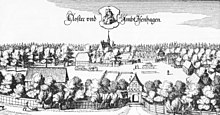Isenhagen Abbey
Isenhagen Abbey is a former Cistercian monastery and today's Protestant women's monastery in Hankensbüttel in the Gifhorn district in Lower Saxony . It is administered by the Hanover Monastery Chamber.
Monastery and monastery history
The monastery name Isenhagen probably derives from its original location on the Ise and the word hag . It was built in 1243 as a Cistercian monastery in today's Hankensbüttel district of Alt-Isenhagen. After it burned down after 16 years of existence, it was rebuilt as a nunnery in 1262. In 1329 it was moved to Hankensbüttel. The third monastery was built at the current location in Isenhagen from 1345. In the course of the Reformation, Duke Ernst the Confessor of Celle converted the monastery into a Protestant women's monastery in 1540 . The nuns and the last Catholic abbess , Margarete von Boldensen, had resisted this since 1529. Finally, as women, they had to submit to the power of the sovereign.
Until the district reform, the Isenhagen district had its seat here.
Property and economic history
The land book of Emperor Charles IV of 1375 documented an interim status of the almost complete sale of the possessions in the Altmark .
History of architecture and art
The gothic s brick buildings house a wealth of medieval furniture and works of art of high rank: carved and painted altars, sculptures, small images for private devotion, especially embroidered altar cloths and frontals which are partially occupied with gold reliefs and pearls.
literature
- Horst Appuhn (author), Jutta Brüdern (recordings): Pictures from Isenhagen Abbey (= The Blue Books ). Langewiesche Nachf. Köster, Königstein im Taunus 1989, ISBN 3-78450480-9 .
- Horst Appuhn: Isenhagen Abbey (= large architectural monuments . Issue 231). 7th edition, Munich / Berlin 1996.
- Wolfgang Brandis (adaptation): Chronicle of the Isenhagen Abbey . 2 volumes, Gifhorn district archive, Gifhorn.
- Eva Grusdt (participation): Part 1. 1578–1720 (= Gifhorn district archive [Hrsg.]: Materials for archive work . Volume 8). 2005, ISBN 978-3-929632-61-3 .
- Rüdiger Brandis (participation): Part 2. 1721–1932 (= Gifhorn district archive [Hrsg.]: Materials for archive work . Volume 12). 2013, ISBN 978-3-929632-92-7 .
- Günter Dickmann: Fight for the monastery. From the nunnery to the evangelical women's monastery. The Reformation among the Cistercian women in Isenhagen . Museum and Heimatverein Gifhorn / Gifhorn district, Gifhorn 1996, ISBN 978-3-929632-33-0 .
- Kirsten Poneß: Isenhagen Abbey (= DKV art guide . No. 678). 1st edition, Deutscher Kunstverlag, Berlin / Munich 2013, ISBN 978-3-422-02368-0 .
- Henning Tribian: Isenhagen Abbey. Local history significance from the foundation to the Reformation . 2nd edition, Calluna, Gifhorn / Oerrel / Uelzen 2014, ISBN 978-3-944946-01-6 .
Web links

- Website of the Isenhagen Abbey
- Description of Isenhagen Abbey on the Lower Saxony monastery map of the Institute for Historical Research
Individual evidence
- ↑ History and Buildings ( Memento of the original from December 1, 2010 in the Internet Archive ) Info: The archive link has been inserted automatically and has not yet been checked. Please check the original and archive link according to the instructions and then remove this notice.
- ↑ Thomas Vogtherr : Abbess Margarete von Boldensen and the introduction of the Reformation in Isenhagen Abbey . In: Niedersächsisches Jahrbuch für Landesgeschichte , vol. 60 (1988), pp. 161–186, here pp. 167–168.
- ↑ Thomas Vogtherr: Abbess Margarete von Boldensen and the introduction of the Reformation in Isenhagen Abbey . In: Niedersächsisches Jahrbuch für Landesgeschichte , vol. 60 (1988), pp. 161–186, here p. 173.
- ↑ Johannes Schultze (ed.): The land book of the Mark Brandenburg from 1375 . Commission publisher von Gsellius, Berlin 1940, [Village register of the Altmark. Das Land Salzwedel.], Pp. 379–411, Isenhagen Abbey: Mühlen der Stadt Salzwedel, p. 380; Jübar p. 401; Lübbars p. 395 (read prepositus instead of prefectus); Bandage p. 396; Drebenstedt p. 401; Groß Grabenstedt p. 403, Mehmke p. 407 (alio monasterio).
- ^ Joachim Stephan: The Vogtei Salzwedel. Country and people from the development of the country to the time of turmoil . Peter Lang. European publishing house of the sciences, Frankfurt am Main 2006, ISBN 3-631-54808-7 , The rural population. The clergy. The Isenhagen Cistercian convent, pp. 153–154.
Coordinates: 52 ° 43 ′ 31.9 ″ N , 10 ° 37 ′ 8.9 ″ E


